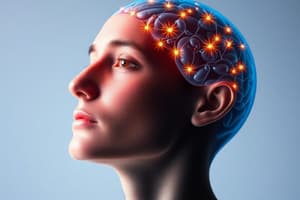Podcast
Questions and Answers
What percentage of females experience headaches?
What percentage of females experience headaches?
What is the first step in evaluating a patient with headache?
What is the first step in evaluating a patient with headache?
What is not a pain-sensitive structure in the cranium?
What is not a pain-sensitive structure in the cranium?
Which of the following is NOT a type of headache?
Which of the following is NOT a type of headache?
Signup and view all the answers
What is a common characteristic of Migraine headaches?
What is a common characteristic of Migraine headaches?
Signup and view all the answers
What is a possible precipitating factor for headache?
What is a possible precipitating factor for headache?
Signup and view all the answers
From which of the following structures can headache be referred?
From which of the following structures can headache be referred?
Signup and view all the answers
How often may Migraine headaches occur?
How often may Migraine headaches occur?
Signup and view all the answers
What happens to the frequency of migraine attacks with age?
What happens to the frequency of migraine attacks with age?
Signup and view all the answers
What is a common precipitating factor of migraine attacks?
What is a common precipitating factor of migraine attacks?
Signup and view all the answers
What is a diagnostic criterion for migraine?
What is a diagnostic criterion for migraine?
Signup and view all the answers
What is a management strategy for migraine?
What is a management strategy for migraine?
Signup and view all the answers
What is a characteristic of tension type headache?
What is a characteristic of tension type headache?
Signup and view all the answers
What is a treatment option for tension type headache?
What is a treatment option for tension type headache?
Signup and view all the answers
What is not a characteristic of tension type headache?
What is not a characteristic of tension type headache?
Signup and view all the answers
What is a common association of tension type headache?
What is a common association of tension type headache?
Signup and view all the answers
Study Notes
Headache
- Headache is a common symptom in clinical practice, affecting 93% of males and 99% of females.
- It is a symptom of a disease that requires searching and every patient with a headache requires a detailed history.
History of Headache
- Duration of suffering from headache
- Is the headache increasing in severity, constant, or paroxysmal?
- Side and site of headache
- Duration of each attack
- Precipitating factors (e.g., cough, psychic stress)
- Relieving factors (e.g., vomiting, analgesics)
- Character of headache
- Associating symptoms
- History of head trauma, nasal obstruction or discharge, visual disorders, teeth problems, etc.
- Is the patient anxious, tense, or depressed?
- Presence of signs of systemic disease (fever, anemia)
Mode of Production of Headache
- All tissues covering the cranium are pain sensitive (e.g., arteries, muscles, and pericranium)
- Skull bone itself is insensitive to pain
- Intracranial pain sensitive structures: venous sinuses, dura matter, and cerebral arteries
Classification of Headache
- Migraine
- Tension type headache
- Cluster headache
- Headache associated with vascular disorders
- Headache associated with head trauma
- Cranial neuralgia
Headache Referred from Diseases
- Skull bone
- Neck (e.g., cervical spondylosis)
- Eyes (e.g., glaucoma, refractive errors)
- Ears (e.g., OM, OE)
- Nose and sinuses (e.g., sinusitis)
- Teeth, jaw, and related structure disorders
- Tempor-mandibular joint diseases
Migraine
- Common in females (15-20%) than males (5-10%)
- Strong family history is present
- Onset: at or shortly after puberty
- Frequency: may occur 2-3 times/week, frequency decreases with age, more frequent at time of menstruation, less frequent during pregnancy
Precipitating Factors of Migraine
- Excitation or excessive work
- Menses
- Bright light
- Extra sleep
- Strong smells
- Minor trauma
- Certain diets (e.g., cheese, chocolate, alcohol, nuts)
Distribution of Pain in Migraine
- Diagnostic criteria of migraine:
- A. At least 5 attacks fulfilling B-D criteria
- B. Headache attacks lasting 7-48 hours
- C. Headache has at least two of the following:
- Unilateral
- Pulsating
- Moderate/severe
- Aggravated by walking or any routine physical stress
- D. During headache at least one of the following:
- Nausea and/or vomiting
Management of Migraine
- I. General measures:
- Avoidance of stressful situations
- Mental and physical fatigue
- Precipitating diet elements
- II. Medical measures:
- During the attack:
- Strong analgesics (e.g., aspirin, paracetamol)
- Ergot preparation (e.g., Migranil) oral, IM, or suppository
- 5HT-receptor agonist (Sumatriptan) given in 6mg SC injection
- Prophylactic measures:
- B-blockers (e.g., Inderal 30-120 mg/day)
- Ca+ channel blockers
- Tri-cyclic antidepressants
- Antiepileptics: valproate and topiramate
- During the attack:
Tension Type Headache
- Frequently associated with anxiety, depressive disorders, and insomnia
- The commonest (68% of males and 88% of females)
- Each attack lasts from 30 minutes up to 7 days
- At least two of the following:
- Pressing/tightening (non-pulsating) quality
- Mild or moderate
- Bilateral location
- No nausea or vomiting
- No phonophobia or photophobia
- May be associated with tender pericranial muscles
- Usually precipitated by stressful situations, associated with insomnia, lost appetite
Treatment of Tension Type Headache
- Analgesics
- Muscle relaxants
- Antidepressants and anxiolytics
Studying That Suits You
Use AI to generate personalized quizzes and flashcards to suit your learning preferences.
Description
Understand the definition and diagnosis of headache, a common symptom in clinical practice, including its duration, severity, and sides affected.




